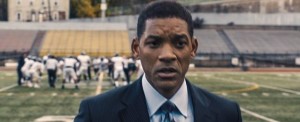Concussions in the NFL are nothing new. But diagnosing them in terms of the extent that repeated concussions have made veteran players susceptible to mental illness and brain disorders later in life, well, that is a tragic new wrinkle and it is the most dangerous side-effect of playing the game. It also is the biggest threat to America’s most popular professional sports game.
In Concussion, Will Smith stars as the most unlikely of medical professionals who discovered this epidemic, Dr. Bennet Omalu. He was a pathologists for the city of Pittsburgh that, upon deeper review of an autopsy for former Pittsburgh Steeler and Hall of Famer Mike Webster (David Morse), found that his brain was not like any the widely respected forensic scientist had ever seen. Chronic traumatic encephalopathy, or CTE, is what he called it and for the NFL — they saw that as what could be the beginning of the end of their sport.
What is so compelling about Concussion is the real life NFL footage that shows the hit after hit that these pros take and give, like Webster, and one can almost feel the damage that it is doing to their brain. What doesn’t hit so hard is Concussion itself. Perhaps the producers and filmmakers felt they had to soften the blow a bit because as Alec Baldwin’s Dr. Julian Bailes (a former team doc for the Pittsburgh Steelers) says, this is an organization that “owns a day of the week.”
Smith digs deeper and finds that other Steeler players have suffered from similar experiences including out-of-control rage, dependency on drugs to sleep, nightmares, and memory issues from simple forgetfulness to complete and utter mental breakdowns.
Peter Landesman directs the film, based on a screenplay he co-wrote that was in turn based on the GQ article Game Brain. Perhaps he was hindered in the filmmaking process by not wanting Concussion to be too much of an indictment on America’s most adored sport, or maybe Landesman simply himself didn’t want to punch through with what it seemed like the material was calling for – an utter dismantling of the game of football itself.
See, there are many scenes in Concussion that show that this type of mentality, this brash head-to-head combat of the game itself starts when players are simply children. It is enforced and strengthened as players become stronger in high school and then in college. Hit after hit after hit is seen and we the audience can see what it is doing to these people. As Omalu says in the film, “God did not want humans to play football.” He cites other animals that smack heads together, including rams, and notes that they have a natural shock absorber in their neck that humans are without.
So, what do we do? It’s hard to watch Concussion without having your enjoyment of the game that happens on any given Sunday be completely altered. Sure, they can make helmets tougher. Sure, the league has upped its game in diagnosing concussions and enforcing players sitting out for a number of games until they’re cleared for returning to combat, er, playing. But, short of dismantling the institution of football itself, it seems like Concussion is fighting a losing battle.
After all, we can’t just end football. Or can we?
Smith is spectacular and carries the film on his shoulders. There’s a love story with his character and the woman who will become his wife and mother of his children that is touching, but sadly a distraction from what Concussion should have been. For those that love the game of football and want to see it thrive and have its players not pay the price over their lifetime, perhaps the film could have provided some answers.
Instead, it just leaves you hanging… like a ball spiraling towards the end zone that we never get to see caught, or even dropped, in the end zone.
Grade: B-



